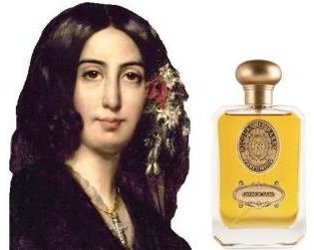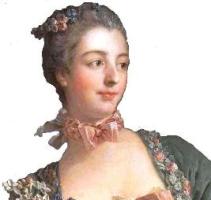
Until recently, perfumer Nicolas de Barry was unknown to me. After sampling his current collection of "historial perfumes" named after famous figures from the past, I've chosen three fragrances with distinctive characters to review today.
L'Eau de George Sand: L'Amoureuse (The Lover)
patchouli, amber, musk, rose, sandalwood, bergamot, lemon, oud; 100 ml Eau de Parfum, 129€
I've already found one perfume I enjoy that's inspired by George Sand; here's another. L'Eau de George Sand starts with a patchouli-amber accord (the patchouli is mid-strength and smells genuine). L'Eau de George Sand's sillage is interesting; this fragrance smells as if it's being worn by another person standing near me — a person who has been bustling about in heavy winter clothes that have been worn and re-worn, and have an accumulation of talc-y rose and sandalwood aromas clinging to them (along with the aromas of the person). L'Eau de George Sand's musk (mercifully "non-white") and oud (faint but natural smelling) combine with citrus peel (and perhaps a smidgen of immortelle) to create a smooth, engaging, finish. This is my favorite Nicolas de Barry fragrance so far (I still have a few to try).
Aside: L'Eau de George Sand is, appropriately, sold at George Sand's home, Nohant.

L'Eau de la reine Margot: La Scandaleuse (The Outrageous)
amber, musk and two types of jasmine — one modern, and jasmin frais à l'enfleurage ancien; 100 ml Eau de Parfum, 129€
Marguerite de Valois, queen of France and Navarre, was the daughter of Catherine de Médicis (herself a lover of perfumes, among other, less savory, things). History, and Nicolas de Barry, may deem Marguerite "outrageous” due to her energetic pursuit of sex, but her love of strong, musk-y scents may have also augmented her carnal reputation and outraged those within smelling distance. Chances are good Marguerite would like L'Eau de la reine Margot.
The perfume opens with sweet florals mixing with pungent musk. My first impression of L'Eau de la reine Margot hasn't changed much over three days of wear: when first sprayed on, it gives an impression that an animal has gotten into my house and defecated in my vicinity. (I'd certainly let L'Eau de la reine Margot dry on skin for at least five minutes before venturing into the company of others...applying it in public might be "provocative"). On one day of wear, the (civet-like) musk predominated; and this musk (be it natural or synthetic) smells of merde, nestled within a lavish bouquet of indolic jasmine blossoms.
After ten minutes on skin, L'Eau de la reine Margot's musk quiets and jasmine blossoms take over (and this phase smells wonderful, even cheery). Thankfully, L'Eau de la reine Margot's long-term sillage presents mostly jasmine (the closer to skin your nose gets the more musk notes you'll detect). Near the end of its development, L'Eau de la reine Margot's musk turns "nutty" and begins to smell of, don't laugh, salted cashews.
L'Eau de la reine Margot's jasmine makes this perfume "addictive" for me...I think of the dirty-musk phase as a brief interlude.

L'Eau de la marquise de Pompadour: L'Ambitieuse (The Ambitious)
iris, mille fleurs, rose, jasmine, gardenia, violet, hyacinth, daffodil, tuberose, amber; 100 ml Eau de Parfum, 129€
Jeanne-Antoinette Poisson, marquise de Pompadour, was ambitious, and powerful, during her 20-year stint as Louis XV's "official" mistress. Not just a beauty, she was an educated person (with friends like Voltaire). The marquise was a patron of the arts — with exceptional taste and the money to see huge projects through to completion (projects like the building of the École Militaire and the Place de la Concorde in Paris, the Petit Trianon Palace at Versailles, a new wing on the palace of Fontainebleau, and the Château de Bellevue).1 Like other members of the Versailles court elite, Madame de Pompadour indulged in scented toiletries to enhance her beauty and to counteract the stench of the palace and its public corridors (where urine, feces and all manner of "unwashed" folk could be found in large quantity).
L'Eau de la marquise de Pompadour is a rich floral brew...intense and spicy (and if sprayed onto a hankie and then held to the nose, could probably block out some foul odors). Certainly, L'Eau de la marquise de Pompadour's mille fleurs bouquet has some carnation in it. Iris comes to the fore quickly and it's a floral, powdery iris, not a damp/root-y iris note. Other florals are discernible at close range, especially rose and jasmine, and there's a "spring flower" accord (cool, wet petals, intense fragrance, mostly hyacinth) that also makes an appearance. As the perfume develops, I smell candied violet alongside a rose water note. L'Eau de la marquise de Pompadour has a "cosmetics" aspect, as if a grand 18th century floral formula were being used to scent creams and powders. There is amber in L'Eau de la marquise de Pompadour, but it is a thin thread running through the composition, adding some support for the flowers but never able to override their scent. I would love this fragrance in a candle or soap; wearing it as perfume is out of the question — it's just too womanly for me. L'Eau de la marquise de Pompadour's lasting power and sillage are good.
Orders can be placed at Nicolas de Barry Maison de Haute Parfumerie (where you can also see a list of shops in Europe selling the perfumes). As far as I know, this line is currently not sold in the U.S.
1. Encyclopaedia Britannica.
Note: top image [altered]; George Sand by Auguste Charpentier, 1835 (Wikimedia Commons). Middle image [altered]; Marguerite de Valois (miniature), Musée Crozatier, Le-Puy-en-Velay, France; no copyright. Bottom image [altered]; La marquise de Pompadour by François Boucher (Wikimedia Commons).
You are always full of surprises, Kevin. I haven’t heard even a whisper about these scents. Thank you for the review.
monkeytoe: you’re welcome, and I’m betting you’re not alone in being unaware of the line!
Drat. I should have skipped to the bottom where it says “not available in the US.” I know I could likely order samples from abroad, but the added challenge makes it far less likely I’ll get around to it. Too bad. These sound worth a sniff!
MR, surely, they’ll get here eventually.
These do sound intriguing!
There are at least two other perfumes inspired by George Sand, the one by Maitre Parfumeur et Gantier, and Casaque by Jean D’Albret. That makes four. It’s fascinating that this unconventional writer is inspiring perfumes more than a century later.
I wonder if any of our current celebrities will be worth celebrating a century from now. By then, of course, perfumistas will be choosing their own themes and asking their perfume printers to do the rest! 😉
Noz: I know…Sand is certainly “alive” in the minds of the French. I never had the chance to sniff Casaque.
PS: and there’s also 1804 George Sand By Histoires De Parfums
Oh, you’re right, I’d forgotten the Hd’P – that’s five!